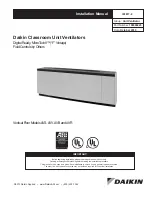
39
have a fan deck(s) that drops down
through the bottom of the unit
by removing 2 screws and quick
connect.
Dirt and dust should not be allowed
to accumulate on the blower wheel
or housing. Failure to keep this
clean may result in an unbalanced
wheel condition which can lead to
a damaged blower wheel or motor.
The wheel and housing may be
cleaned periodically using a brush
and vacuum cleaner, taking care
not to dislodge the factory applied
balancing weights on the blower
wheel blades. Clean the blower at
every inspection. Any blower or
motor that is not properly maintained
will not be covered under the
manufacturer’s warranty.
Coil
Coils may be cleaned by removing
the motor/blower assembly, providing
access to the air entry side of the coil.
Brush the entire finned surface with a
soft bristled brush, brushing parallel
to the fins, taking care not to damage
the fins. Brushing should be followed
by cleaning with a vacuum cleaner.
Compressed air can also be used by
blowing air through the coil fins from
the leaving air side, again followed
by vacuuming. If fins are damaged
during the cleaning process, a 12
fins per inch fin comb can be used to
straighten the fins.
For a deeper cleaning, spray the
finned surface with a neutral cleaning
solution and rinse thoroughly.
Zehnder Rittling recommends
using neutral pH cleaners.
Avoid the use of strong acids
and strong base cleaners.
Thus, cleaners with pH range
from 5 to 11 are suitable for coil
cleaning. This range includes
such over-the-counter cleaners
as Simple Green
®
All Purpose
Cleaner, or HVAC coil cleaners
like Nu-Calgon Evap Pow'r
®.
Strong acidic cleaners (pH of 5
or less) that contain hydrochloric,
sulfuric, nitric or acetic acid
are not recommended for use
on copper-tube, aluminum fin
coils. Presence of these acids
will result in rapid corrosion of
the metals. Strong alkali (base)
cleaners (pH of 11 or more)
containing sodium, potassium
or ammonium hydroxide are
not recommended as they will
aggressively corrode aluminum
tubes and fins. Strong ammonium
hydroxide cleaners will also
cause stress corrosion cracking
of copper tubes. Zehnder
Rittling recommends completely
rinsing all cleaners from the coil,
including cleaners identified
as no-rinse cleaners. Residual
cleaners may decompose over
time producing low molecular
weight, organic acids that lead to
formicary corrosion.
Failure to maintain a clean coil
surface will result in reduced
airflow, reduced performance
and increased power
consumption. Clean the coil at
every inspection. Units provided
with the proper type of air filters,
replaced regularly, will require
less frequent coil cleaning.
Normal operation and periodic maintenance
General
Each unit on a project will
have its own unique operating
environment and conditions
which dictate a maintenance
schedule for that unit that
may be different from other
equipment on the project. A
formal regular maintenance
schedule and an individual
unit log should be established
and maintained. Following this
schedule will help maximize the
performance and service life of
each unit on the project.
The safety considerations listed
in the front of this manual should
be followed during any service
and maintenance operations.
For more detailed service
information consult your Sales
Representative or the factory.
Disconnect power supply from
the unit before servicing.
Motor/blower assembly
The type of fan operation is
determined by the control
components and their method of
wiring. This may vary from unit to
unit. Refer to the wiring diagram
located in a zip-lock plastic bag
in the electrical end pocket of
each unit for that unit’s individual
operating characteristics.
All motors have permanently
lubricated bearings so no further
field lubrication is ever required.
If the motor/blower assembly
ever requires more extensive
service such as motor or blower
wheel/housing replacement, the
entire assembly can be removed
from the unit. Horizontal units






































